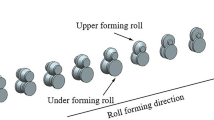Abstract
The transverse bowing greatly affects the accuracy of the roll-forming asymmetric corrugated channels (ACC). In order to control this defect, the paper first elucidates its mechanism of the production. Then, the transverse bowing is explored by finite element method (FEM) using ABAQUS 2016 software and the effects of its forming parameters are analyzed. Also, a linear regression model is built using Minitab 19 software to evaluate their effects, of which standard values are measured by a Pareto chart. It is observed that the number of forming channels has the greatest effect, followed by the roll gap and bending angle, and the friction coefficient has the least. Finally, to decrease the transverse bowing defect (TBD), the dominant forming parameters are optimized according to the evaluation results and the operating conditions. And the results of simulation and optimization are verified by the experiments, respectively. This research shows that the TBD can be greatly controlled through the optimization of three dominant forming parameters including the roll gap, bending angle, and inter-station distance for given ACC.

















Similar content being viewed by others
Data availability
Not applicable.
References
Xu C, Wei Y, Pan T, Chen J (2021) A study of cold roll forming technology and peak strain behavior of asymmetric corrugated channels. Int J Adv Manuf Technol 118(11–12):4213–4223
Poursina M, Tehrani MS, Poursina D (2008) Application of BPANN and regression for prediction of bowing defect in roll-forming of symmetric channel section. IntJ Mater Form 1(s1):17–20
Abvabi A, Mendiguren J, Kupke A, Rolfe B, Weiss M (2017) Evolution of elastic modulus in roll forming. IntJ Mater Form 10(3):463–471
Guan YZ, Li Q, Yan Y (2012) Fracture finite element analysis for roll forming of U section parts of TRIP 600 steel. Appl Mech Mater 249–250:874–880
Murugesan M, Sajjad M, jung D, (2021) Experimental and numerical investigation of AA5052-H32 Al alloy with U-profile in cold roll forming. Materials 14(2):470–489
Qian Z, Zhao Y, Wang C, Liu S, Xiong Z, Meehan P, Daniel W, Ding S (2021) Numerical and experimental investigation of the bending zone in free U-bending. J Manuf Sci Eng 143(9):1–32
Cha WG, Kim N (2013) Study on twisting and bowing of roll formed products made of high strength steel. Int J Precis Eng Manuf 14(9):1527–1533
Tehrani MS, Hartley P, Naeini HM, Khademizadeh H (2006) Localised edge buckling in cold roll-forming of symmetric channel section. Thin-Walled Structures 44(1):184–196
Zeng G, Li SH, Yu ZQ, Lai XM (2009) Optimization design of roll profiles for cold roll forming based on response surface method. Mater Des 30(6):1930–1938
Wiebenga JH, Weiss M, Rolfe B, van den Boogaard AH (2013) Product defect compensation by robust optimization of a cold roll forming process. J Mater Process Technol 213(6):978–986
Bui QV, Ponthot JP (2008) Numerical simulation of cold roll-forming processes. J Mater Process Technol 202(1–3):275–282
Rossi B, Degée H, Boman R (2013) Numerical simulation of the roll forming of thin-walled sections and evaluation of corner strength enhancement. Finite Elem Anal Des 72(9):13–20
Paralikas J, Salonitis K, Chryssolouris G (2008) Investigation of the effects of main roll-forming process parameters on quality for a V-section profile from AHSS. Int J Adv Manuf Technol 44(1):223–237
Li ZX, Shu XD, Yin AM, Guo DL (2018) Experimental and numerical analysis on the forming and shearing quality of C-channel steel. Int J Adv Manuf Technol 94(9):3665–3678
Narasimhan A, Lovell M (1999) Predicting springback in sheet metal forming: an explicit to implicit sequential solution procedure. Finite Elem Anal Des 33:29–42
Safdarian R, Moslemi Naeini H (2015) The effects of forming parameters on the cold roll forming of channel section. Thin-Walled Structures 92(3):130–136
Bhattacharyya D, Smith P, Yee C, Collins I (1984) The prediction of deformation length in cold roll-forming. J Mech Work Technol 9(2):181–191
Park H, Anh T (2010) Finite element analysis of roll forming process of aluminum automotive component. Int Forum Strat Technol 2010:5–9
Bidabadi BS, Naeini HM, Tehrani MS, Barghikar H (2016) Experimental and numerical study of bowing defects in cold roll-formed U-channel sections. J Constr Steel Res 118(3):243–253
Funding
This project is supported by programs for the Natural Science Foundation of Liaoning Province and Intelligent Industry of Anshan Iron and Steel Corporation (2020-KD-1001).
Author information
Authors and Affiliations
Contributions
Chun-Tian Xu: writing original draft, participating, and guiding the programs.
Jian-Chao Chen: simulation of part research and collection of experiment data.
Yi-Fan Wei: simulation of part research and collection of experiment data.
Han Han: collection of experiment data.
Xu Zong: program partner and guiding.
Ye Yuan: program partner and guiding.
Corresponding author
Ethics declarations
Ethics approval
Not applicable.
Consent to participate
Not applicable.
Consent for publication
Not applicable.
Competing interests
The authors declare no competing interests.
Additional information
Publisher's note
Springer Nature remains neutral with regard to jurisdictional claims in published maps and institutional affiliations.
Rights and permissions
Springer Nature or its licensor (e.g. a society or other partner) holds exclusive rights to this article under a publishing agreement with the author(s) or other rightsholder(s); author self-archiving of the accepted manuscript version of this article is solely governed by the terms of such publishing agreement and applicable law.
About this article
Cite this article
Xu, CT., Chen, JC., Wei, YF. et al. A study of transverse bowing defect in cold roll-forming asymmetric corrugated channels. Int J Adv Manuf Technol 124, 3567–3577 (2023). https://doi.org/10.1007/s00170-022-10743-w
Received:
Accepted:
Published:
Issue Date:
DOI: https://doi.org/10.1007/s00170-022-10743-w



